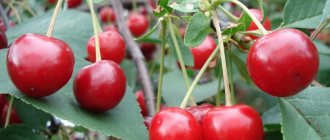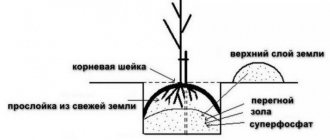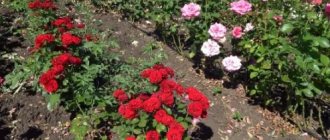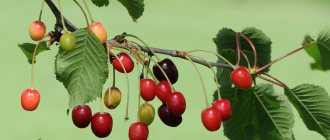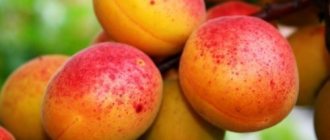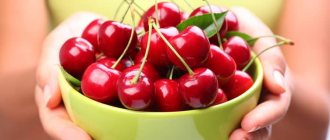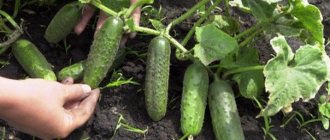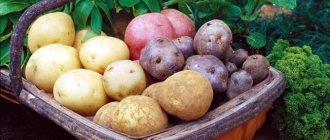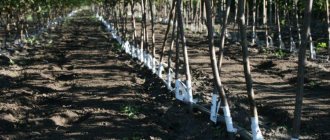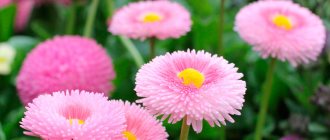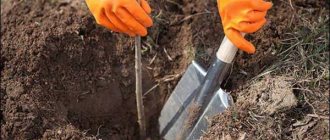History of selection
I.V. Michurin is the author of the first frost-resistant varieties of cherries. Now, when creating new winter-hardy forms, his Kozlovskaya, Pervenets, and First Swallows are used as source material. In Soviet times, the center of selection was the Pavlovsk experimental station of the VIR. There, 14 winter-hardy varieties of cherries were bred for the Moscow region and Leningrad region.
At dachas near St. Petersburg you can still find:
- Leningrad yellow;
- Red dense;
- Zorka.
Many varieties were created by breeders of the Bryansk Experimental Station. Their cherries Revna, Iput, Teremoshka, Compact Venyaminova, Ovstuzhenka, Bryanochka, Pink Sunset, Veda, Tyutchevka, Bryansk pink are popular among summer residents. Cheremashnaya and Fatezh cherries are considered the most winter-hardy varieties of Moscow selection (VSTISP).
Main characteristics
Cherries grown beyond the Urals are no longer exotic. Many years of work by breeders and the perseverance of gardeners have done their job; the heat-loving crop has found its niche in Siberian amateur gardens. It freezes in open areas, so it is grown in a place protected from the winds. Fences, outbuildings, and houses serve as shelter.
Important!
In open areas, cherries are grown in stale form; for this, seedlings are planted at an angle of 45 degrees, and the crown is formed using stretch marks. The yield of cherry trees does not exceed 10 kg per tree.
The culture is very demanding on the structure and fertility of the soil. It should be light, fertile, but not over-fertilized. If the thickness of the cultural layer is less than 20 cm, the cherry tree develops poorly, lives little, and bears scanty fruit.
List of lands on which it is impossible to grow a fruit-bearing cherry orchard:
- sandy;
- clayey;
- peat bogs.
Cherry trees also have special requirements for lighting. Trees growing in the shade develop an asymmetrical, one-sided crown. They have poor fruiting because there are few bouquet branches. The crop does not tolerate waterlogging and short-term flooding.
In the south, cherry trees growing in the wild grow up to 20 meters. They have a spreading crown and thick side branches. Cultivated varieties do not exceed 7 m, but their desire to constantly grow upward makes it difficult to care for the crown.
According to height, all varieties are divided into 3 groups:
- undersized;
- medium height;
- vigorous.
For Russian gardeners who buy seedlings, the frost resistance of cherries is important. It can be winter-hardy, medium-winter-hardy and low winter-hardy. After planting, the trees bloom for the first time and begin to bear fruit after 4-7 years. The flowers bloom in the spring before the leaves appear. The ripening period (June, July, August) depends on the variety. In the southern regions of the Russian Federation, early cherries are harvested in May, late cherries - at the end of summer.
Characteristics and beneficial properties of fruits
Russians love and are happy to buy cherry fruits. There are about 3 thousand cultivated varieties, each berry has its own taste, shape, size, color, stalk length, and seed size.
| Fruit color | Variety | Taste | |
| Sweet | Sweet and sour | ||
| Black (dark red) | Leningradskaya black | + | |
| And the way | + | ||
| Bull's heart | + | ||
| Daibera black | + | ||
| Pink | Pink pearl | + | |
| Leningradskaya pink | + | ||
| Bryansk pink | + | ||
| Early pink | + | ||
| Yellow | Radiant light | + | |
| Drogana yellow | + | ||
| Cheremashnaya | + | ||
Berries weighing more than 5 g are considered large, from 3-5 g - medium, less than 3 g - small. They are round and heart-shaped in shape. Cherry varieties are divided into 2 classes: bigarro and guini. The structure of the pulp underlies this classification:
- bigarro includes varieties with dense, shelf-stable, transportable fruits that can be dried, canned, and frozen;
- The gini group includes varieties whose fruits are tender and easily wrinkled.
In the garden, cherries are the first to ripen; eating a handful of ripe berries can quench your thirst, hunger, and improve your well-being and mood. The benefits of fruits have long been proven. Their juice contains antioxidants that remove toxins, normalize metabolic processes, and prevent the formation of blood clots.
For people suffering from anemia, the sweet, juicy berry is especially useful. Its pulp contains iron and vitamins. They also contain salicylic acid, which relieves pain that occurs with gout and arthritis, and contains fiber that improves intestinal function.
The berries are eaten fresh or processed. Dark-colored varieties are used in home winemaking. Yellow fruits are frozen and dried for the winter. Cherry juice has an anti-inflammatory effect. They treat eczema and acne.
Pollinators
In order for cherries to bear fruit, at least 2-3 seedlings of different varieties are planted in the garden. One will not bear fruit, the fruits will not set at all, or there will be very few of them. The table shows cherry varieties popular among gardeners in the Middle Zone, and for each there is a list of the best pollinators.
| Variety | Pollinators |
| Adeline | In memory of Chernyshevsky, Teremoshka, Pink Pearl, Rechitsa |
| Leningradskaya black | Veda, Bryanochka, Iput, Revna, Michurinka |
| In memory of Chernyshevsky | Poetry, Teremoshka, Adeline, Pink Pearl |
| Bryanochka | Tyutchevka, Iput, Leningradskaya black, Revna, Michurinka |
| Ovstuzhenka | Raditsa, Iput, Tyutchevka, Revna |
| Bryansk pink | Ovstuzhenka, Iput, Tyutchevka, Revna |
| Veda | Bryanochka, Revna, Tyutchevka, Iput, Leningradskaya black |
| And the way | Tyutchevka, Ovstuzhenka, Revna, Bryansk pink, Tyutchevka |
| Leningradskaya pink | Rechitsa, Teremoshka, Adeline, Pink Pearls, In Memory of Chernyshevsky |
| Fatezh | Iput, Cheremashnaya, Raditsa, Ovstuzhenka |
| Cheremashnaya | Fatezh, Iput, Raditsa, Ovstuzhenka |
Cherries are often used as a pollinator. Select varieties that bloom at the same time as cherries. In order to enhance the effect of cross-pollination, seedlings are planted in a dense pattern with an interval of 3 m in a row.
Landing Features
Planting Fatezh cherries is not much different from other varieties. The peculiarities of the planting process are more likely related to climatic conditions, since this variety is zoned for a region in which the cultivation of cherries is generally uncharacteristic.
Recommended timing
In the Central and Northwestern regions, it is best to plan planting Fatezh cherries in the spring, since young and weak seedlings may not tolerate winter frosts after autumn planting.
In southern regions with mild winters, you can plant cherries in October, 15-20 days before the planned onset of frost. During this time, the cherry tree will have time to take root in a new place. The condition of the root system also influences the planting date. A seedling with bare roots can take root only when planted in spring; plants in a container (with a closed root system) successfully take root both in spring and autumn.
The optimal time for planting Fatezh cherries in the spring is April; if spring comes late, then planting can be postponed to the beginning of May.
Choosing a suitable location
The choice of landing site should be taken seriously. Fatezh cherry is demanding both in terms of soil quality and location on the territory. Heavy clay soils with close groundwater, open areas with strong winds and drafts, northern slopes and shaded areas, as well as lowlands are absolutely not suitable.
Areas fenced from the wind are well suited for planting cherries: old gardens, southern forest edges and slopes. It is allowed to plant Fatezh cherries along the walls of the house, but you need to retreat at least 3 m to avoid problems with the foundation in the future.
It is also worth considering that cherries need a well-lit area and light, well-drained loamy soil. Soil acidity should be neutral within 6-7 pH. Groundwater occurrence is at least 2 m deep. Otherwise, you need to either form a high bed or artificially create a high-quality drainage layer.
What crops can and cannot be planted next to cherries?
Proper proximity helps plants develop more actively and protects them from diseases and pests. Since Fatezh cherries do not self-pollinate, it is recommended to sow honey-bearing herbs nearby. They actively attract bees and prevent the growth of weeds.
Recommended honey plants:
- clover;
- mustard;
- phacelia.
For active growth of Fatezh cherries, any trees and shrubs with stone fruits are suitable:
- cherry;
- apricot;
- plum;
- grape.
The following crops are not suitable for growing together:
- Nightshades (tomatoes, potatoes, peppers) – spread diseases.
- Gooseberries, raspberries, currants take away nutrients.
- Sea buckthorn – blocks the development of the root system.
Description of winter-hardy cherry varieties for the Urals and Siberia
Winter-hardy varieties of cherries growing beyond the Urals, adapted for Siberia, are having a hard time. The cold period there lasts a long time; frosts of 40 degrees are not uncommon. Frosts occur in May and even in June, and flowers and flower buds suffer from them.
For regions with short summers and cold winters, low-growing varieties of cherries are suitable, in which the tree height does not exceed 4-4.5 meters. The smaller the crown, the easier it is to bend it down and cover it in winter. Those branches that are under the snow do not suffer from frost.
Cherry selection is carried out at the Lupine Research Institute, located in the Bryansk region. It was there that early ripening, frost-resistant forms were developed for the gardens of Siberia and the Urals:
- Ovstuzhenka (a group of northern varieties) deserves attention. This is a mid-season, productive (30-50 kg), self-fertile variety that can withstand frosts of -45 °C.
- Tyutchevka cherries can only be grown as a cover crop. This form does not have high winter hardiness - -25 °C, but with good care and covering the crown for the winter it can withstand -35 °C.
- An interesting, new variety, Pamyati Astakhov, was developed recently (2014), its frost resistance is -32 °C. Sweet cherries bear fruit well if winter-hardy Ovstuzhenka or cherries grow in the garden. The variety itself is self-sterile.
- The relatively new (2001) Teremoshka variety is distinguished by its high winter hardiness; as practice has shown, it can withstand short-term frosts down to -34 °C, and during prolonged bad weather, wood (2%) and buds (40%) suffer. To bear fruit, cherries need pollinators (cherry, Ovstuzhenka).
In addition to the varieties listed above, Iput, Krasnaya Gorka, Bryansk pink, Cheremashnaya, Fatezh, Bryanochka cherries are suitable for the Urals and Siberian regions.
Further care
After planting, cherry seedlings require regular care. Plants should be watered only when necessary at a rate of 40 liters per season. Every spring the garden is sprayed against insects and major crop diseases.
Fertilizer application is carried out according to the following scheme:
- Twice a year for young plants. The first feeding is in May, the second in June.
- Mature trees are fertilized 4 times per season. The complex is applied 4 times at equal intervals from May to August.
To improve the persistence of cherries, as well as effective pollination, trees can be grafted with other varieties. The procedure increases winter hardiness and rejuvenates the old tree. The introduction of cuttings onto the rootstock is carried out in the spring, at an air temperature of +5°C, but before the start of sap flow.
Winter-hardy cherry varieties for the Moscow region
There are winter-hardy varieties of self-fertile cherries for the Moscow region. Some of their flowers are self-pollinating, but they still need pollinators for abundant fruiting. Most often, summer residents look for seedlings of Fatezh, Narodnaya Syubarova, Revna, Valery Chkalov, Cheremashnaya, Iput. The harvest is harvested in June.
The path ripens early, at the end of June, and Cheremashnaya and Valery Chkalov are not far behind. Other early varieties for the Moscow region: Krasnaya Gorka, Ovstuzhenka, Priusadnaya yellow. The fruits of Fatezh, Narodnaya Syubarova, Revna ripen in the average time. The harvest is harvested in July.
To enjoy cherries from late July to mid-August, late-ripening varieties are planted in the garden: Leningradskaya Chernaya, Podarok Stepanov, Michurinka. The harvest is harvested in August.
Sadko
The variety is quite new, obtained in 2005. It combines many positive qualities inherent in modern varieties. This includes the short growth of trees with a non-thickening crown, their stable yield (about 85 kg), and resistance to returning cold in the spring, and to severe frost in winter. It is also worth noting resistance to diseases and the vast majority of pests. The Sadko variety lacks only self-fertility. But what a wonderful taste his cherries have!
I would like to talk about them separately. There is no person who would not appreciate the taste of these ruby berries! It is easy to understand that the cherries are ripe by their rich red color. It is during this period that you should pick the berries in order to experience the fullness of their taste with an abundance of sweet, clear juice.
Cherries are suitable for any type of processing and, of course, they are good fresh! The berries ripen almost simultaneously, so that in one trip to the dacha you can harvest up to 90% of the entire harvest.
Entry into fruiting Tree height (m) Fruit weight (g) Harvesting Pollinator varieties
For 4th year 4.0-4.2 6.1-8.1 End of June
Iput, Ovstuzhenka, Odrinka
Winter-hardy cherries for the Middle Zone
Central Russia is a large territory. The climate in the northern regions, for example, in the Vologda region, is harsher than in the central part, but quite mild. Attempts to grow southern cherries there end in failure. For amateur gardens, nurseries offer varieties of increased frost and winter hardiness, bred at the Pavlovsk Experimental Station (VNIIR).
The northern group includes:
- Red dense;
- Leningrad pink;
- Leningradskaya black;
- Leningrad yellow;
- Zorka.
With proper preparation, these varieties can withstand frosts of -25-27 °C without severe damage. If low temperatures persist for a long time, some of the flower buds freeze. At critical temperatures (-30-35 °C) the crown freezes to the snow line.
Important!
Trees in which the grafting site has not frozen over are restored. A new crown is formed within 3-4 years. The yield of such cherries is lower, and they do not live long.
Comparative characteristics of yield
There are no varieties in the State Register for the northwestern and northern regions, but summer residents successfully grow cherries and collect statistics (yield, early fruitfulness, winter hardiness).
| Variety | Productivity | Beginning of fruiting |
| And the way | 30 kg | 4-5 year |
| Red dense | 10-15 kg | 4 year |
| Leningradskaya pink | 15 kg | 3-4 year |
| Leningradskaya black | 20 kg | 3-4 year |
| Leningrad yellow | 15-20 kg | 3-4 year |
| Zorka | 20 kg | 3-4 year |
| Gift for Stepanov | 60 kg | 4 year |
| Michurinka | 30 kg | 5-6 year |
| People's Syubarova | 50 kg | 4 year |
| Revna | 30 kg | 5 year |
| Bryansk pink | 30 kg | 5 year |
| Cheremashnaya | 10-15 kg | 4 year |
| Fatezh | 30 kg | 3-4 year |
| Bryanochka | 15-20 kg | 5 year |
| Valery Chkalov | 62 kg | 5 year |
| Ovstuzhenka | 15 kg | 5 year |
| Early pink | 20 kg | 4-5 year |
| Daibera black | 90 kg | 5 year |
More about the top seven
In our top, self-fertile varieties are arranged in descending order of character. But nevertheless, by giving preference to at least a few species from this list, you will be able to get a decent harvest, which they will delight you with, even without pollinators in the neighborhood.
Homestead yellow
This variety is rightfully the leader on our list. Among self-fertile species, it has the highest degree of manifestation of this trait. The cherries are medium-sized and begin to bear fruit quite quickly. They are resistant to pests and diseases, have high frost resistance and resistance to return spring frosts. Therefore, gardeners willingly grow this species in large areas. The fruits have a beautiful golden-yellow color and are well preserved even in rainy weather; they do not crack or fall off.
Bereket
The variety can also be classified as an early variety, since the harvest can be harvested in early to mid-June. One of the youngest varieties obtained by breeders at the beginning of this century. It has all the characteristics of new varieties: frost- and drought-resistant, disease resistance. Does not require formative pruning. Therefore, it is ideal for summer cottages. To increase productivity, you need to plant one of the pollinators nearby for pollination - Iput or Revna. Bereket begins to bear fruit at 4-5 years. The berries are a beautiful dark red color, with juicy pulp. The fruits are dense, so they can be transported over long distances. The taste is excellent.
Goryanka
The variety rightfully belongs to the old-timers, it was bred in the last century, however, it has not lost its valuable qualities. Rather, on the contrary, this is why it is often preferred by small farms, and not just amateur gardeners.
The trees are drought- and frost-resistant, not susceptible to diseases and pests. Even if there is no pollinator nearby (Iput and Revna), the variety bears fruit well, producing a good harvest of very tasty dark burgundy berries. The stone is small and easily separated from the pulp. The fruits are storable and can be transported far. Ripen in early to mid June.
Tyutchevka
One of the modern species with good self-fertility. But when pollinated with Ovstuzhenka or Raditsa, the yield will increase significantly.
Tyutchevka is resistant to frost and frost, pests and diseases. The trees are small in height for cherries, so they are grown in the smallest areas.
The dark red juicy berries have an excellent taste and are easily separated from the long stalk. When ripe, they do not crack or fall off. Well transported.
By planting self-fertile varieties of cherries, you can get a decent harvest, which they will delight you with, even without pollinators in the neighborhood. The illustration for the article is used under the standard license ofazende.com
Danna
If you want to grow cherries that don't have any drawbacks, then this is Danna. Pyramidal crown without thickening, only sanitary pruning is needed.
Highest resistance to everything from frost to pests. The berries are large, dark red, with juicy, tasty pulp. The harvest can be harvested starting in June.
When Iput or Revna are adjacent, the yield increases significantly.
Dolores
You won’t be indifferent if you try the fruits of this cherry and see them in all their beauty on the tree. The berries are very large, dark burgundy in color. Fragrant, with juicy pulp and a small seed. They have a pleasant sourness.
The variety is also hardy. When pollinated (Iput and Revna), the yield is higher.
Advice from experienced gardeners
Novice gardeners find useful advice on forums. There is a lot of useful information about cherry varieties and the features of agricultural technology. For example, an amateur gardener from Voronezh recommends stopping the growth of new shoots in the second half of summer with potassium fertilizers. This problem is relevant for any region.
Young shoots will freeze in winter if they do not finish vegetating 2 months before the onset of frost. In order for the tree (bush) to acquire the necessary hardening - the bark becomes lignified, potassium magnesium is added to 1 m² of the tree trunk circle in a matchbox, and 2 weeks before the first frost, moisture-charging watering is carried out.
